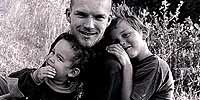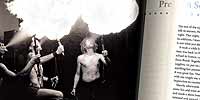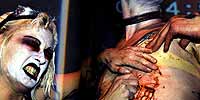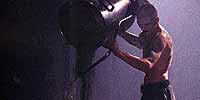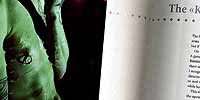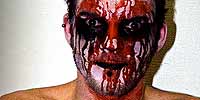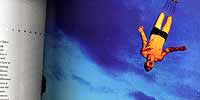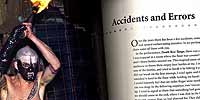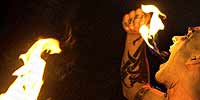 |
 Ten Years of Pain by Håvve Fjell – Review by Shannon Larratt |
||||||||||||||||||||||||||||||||||||
This may well be the best body play related book I have ever read (wow!). It is the first book in a long time where I’ve been felt an empathic connection with the content and been drawn deeper and deeper as I progressed. Not since I was a child reading science fiction on winter nights have I been so singularly possessed by a work of prose.
Håvve Fjell is the core of Pain Solution, a Norwegian performance art group — although it has also been a solo project for much of its existence. He exemplifies the modern fakir, both in the sense of performance, fine art, spirituality, and social consciousness. This book, photographed by Håvve’s sister Helene, is an intimate, unflinching, and deeply personal and engaging documentation of his first ten years — as Helene puts it, “Håvve is honest and he has something to say.” The book is written almost entirely in the first person, and its open style makes you feel like you’re reading Håvve’s thoughts. 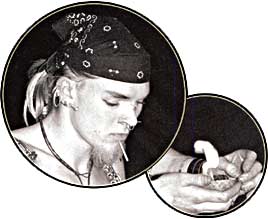 Just over two years ago Håvve was asked to speak about self-harm at a Psykopp-organized lecture for psychiatrists, psychotherapists, and doctors — they were so drawn into the dialog that they approached him about producing a book on the subject. He begins this book by describing his childhood,
Sound familiar? In 1991 Håvve traveled to Brazil to develop his skills. In Brazil he met other performers, and did his first fakir show — to an audience who was not expecting or desiring his style of show, and jeered him with taunts of “disgusting”, “sick pervert” and “ugly”.
His confidence returned along with his return to Oslo, where he put on another show with friends (much more successfully) and started thinking about combining the fakir element with performance and stage art. Along with his friends Eirik and Roberto he decided that maybe they could even make a little money if they built a show around fire, juggling, fakirism, and music, and in 1993 PSI (Pain Solution Inc.) was founded. The first show was a success, but they quickly lost their backing band. The group shuffled members for a while, and Håvve took courses in street theatre, mime, clowning, and acting, and became more and more serious about the professionalism of his show. He returned to Brazil for some time and then back to Norway where he slowly re-tooled his shows for a broader audience — Pain Solution was getting TV gigs, many shows, and media appearances — and also worked with puppet theatre and other art-forms.
For Y2K Pain Solution was contracted to perform at the largest millennium event in Norway, a huge fire show on New Year’s even in Oslo. After being the pinnacle act in front of 200,000 people Pain Solution started getting larger contracts for custom performances, and Håvve began building a network of actors, contortionists, jugglers, and other performers to work with as shows dictated. Shows got even larger, and in 2001 Pain Solution co-produced Ringen with the Haugesund Theatre, a modern circus group. Large projects always put a lot of stress on a group, and Håvve decided to revert Pain Solution back to being a solo production. He was then invited to do a series of performances for the Industrial Art Museum in Oslo, and presented them with a plan to do a sculptural or “poetic” suspension. They turned him down, saying that he would scare off their “elderly guests”. Håvve was furious — he’d been promoting the event for three weeks, and his art was being muted.
 The demonstration was a success and the publicity led the House of Artists to contract Håvve to perform Censored, as well as Floating, the project which had been censored. Since it was a six-week installation, Håvve expanded it to Kvintett, five performances of physical restrictions — full body casting, flesh sewing, buried in broken glass, a Chinese-water torture-type event, and a horizontal suspension. The book describes his experiences and encounters in all of these. However, after this successful series of performances (with a great deal of media and critical attention), Håvve again found himself alone and in debt — for the first time in his life, he had to get a job. Of course, with no education or experience, the best he could do was two part-time jobs — and he feared that a full-time job could interfere with his ability to continue developing Pain Solution. Kvintett had given him a new area to explore as an artist and a fakir — his own personal approaches to pain. His performances became more esoteric, and Håvve became an explorer and researcher as much as an artist.
…which brings the specific history of Pain Solution up to date.  Håvve also communicated with Allen Falkner of TSD in Texas, and after doing a number of suspensions in private and in public (as mentioned above), beginning in 2002 he began co-organizing the annual Wings of Desire – Oslo Body Suspension Festival, an event similar to the SusCons hosted by various suspension groups around the world. He also talks about how hard it’s been for him to achieve spiritual experiences, largely due to the attention he must also pay to the stage aspect. Addressing something too many amateur performers overlook, Håvve warns about some of the accidents that have happened on stage, including one horrific experience where he breathed in a lungful of paraffin, leading him to ten days hospitalization after the performance. Other shows left him with serious burns, and another with cuts in his hand that resulted in permanent nerve damage. Like many of us, he’s had last minute supply and preparation problems, rigging failures, and other mishaps. “Shit happens and the show must go on!” The conclusion to the book contains commentary from many of the other members of Pain Solution mentioned in the book, both performers and technical staff. It also contains some interview excerpts and fine arts analysis of Håvve’s performances (“In search of a lost pain” by the Bureau of Contemporary Art Praxis, Rijeka, Croatia, and “Toward the aesthetics of pain” by Stahl Stenslie, Academy of Media Arts, Colgne Germany), commentary from Målfrid J. Frahm Jensen and Per Johan Isdahl (Ullevål University Hospital, Oslo) on the self-harm aspects, and from Siv Ellen Kraft (University of Tromsø, Norway) on the religious aspects. The book then finishes with a short FAQ. This really is a remarkable book. My review does not do it the justice it deserves. I literally believe it is the only book that has been able to take such a snapshot. I do not believe that any body modification book collection can be called complete without this book, and I believe this is essential reading for anyone involved in performance or body art as well as those interested in art history and body-art/modification/play-history. 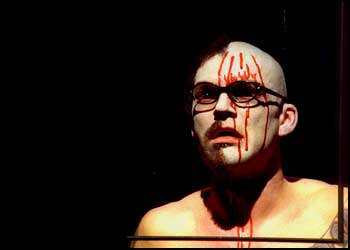 From a technical point of view the printing in this book is gorgeous. It’s large format (10”x10”) and full color with silver spot color throughout its 180 pages and almost every page has photos. The text is clear and easy to read and the photos are bright, crisp, and vibrant (all the pictures in this review are of course from the book). I have nothing bad to say about the book on a conceptual or artistic level, but I do have two complaints in the technical area:
I believe that this book will touch you. It might get banged up a little easier than it should, and maybe it costs a little more than is normal, but this book will touch you. For me, it’s worth every cent, and I believe that if you’re a regular BME reader and you appreciate what’s being done here in general, this book will reach you as well. As far as I know BMEshop is the only place this book is available online. Because I believe in it so strongly I have given up all royalties and commission on its sale in order to ensure the best possible price for you. Please note that we only have a few in stock right now, so if you visit the page and it’s sold out, please be sure to add your name to the “tell me when it’s back” list.
PS. Be sure to check out the Pain Solution website at www.painsolution.net! This page and its contents are © 2004 Shannon Larratt – Reproduced under license by BMEzine.com LLC. All rights reserved. Requests to reprint must be confirmed in writing. For bibliographical purpose this review was published January 21st, 2004 in Toronto, Canada. |
|||||||||||||||||||||||||||||||||||||
Post navigation
 BME/News and Modblog highlight only a small fraction of what BME has to offer. Take our free tour and subscribe to BME for access to over 3 million body modification related photos, videos, and stories.
BME/News and Modblog highlight only a small fraction of what BME has to offer. Take our free tour and subscribe to BME for access to over 3 million body modification related photos, videos, and stories.
